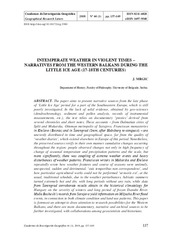| dc.description.abstract | The paper aims to present narrative sources from the late phase of 'Little Ice Age' period for a part of the Southeastern Europe, which is still poorly investigated. In the lack of solid evidence, obtained by geo-sciences (dendrochronology, sediment and pollen analysis, records of instrumental measurements, etc.), the text relies on documentary 'proxies' derived from several chronicles and short notes. These accounts - from Dalmatian cities of Split and Makarska, Ottoman metropolis of Sarajevo, Franciscan monasteries in Kresevo (Bosnia) and in Sarengrad (Srem, after Habsbur gre-conquest) - are unevenly distributed in time and geographical space, far from the quality of 'weather diaries', which existed elsewhere in Europe of this period. Nonetheless, the preserved sources verify in their own manner cumulative changes occurring throughout the region: people observed changes not only in high frequency of change of seasonal temperature and precipitation patterns and the scale, but more significantly, there was coupling of extreme weather events and heavy disturbances of weather patterns. Franciscan writers in Makarska and Kresevo repeatedly wrote how weather features and course of seasons were untimely, unexpected, sudden and detrimental, 'suis temporibus non correspondens', and how particular agricultural works could not be performed 'ut moris est', at the usual, traditional schedule, due to the weather perturbances. Adriatic summers turned extremely hot and dry, with long periods without any rain, while data from Sarengrad corroborate results obtain in the historical climatology for Hungary on the severity of winters and long period of frozen Danube River. Mulla Basheski's records from Sarajevo yield information on Miljacka River flood events, in connection to both climate condition and land-use patterns. This paper is foremost an attempt to draw attention to research possibilities for the Western Balkans, and there are more documentary, narrative and archival sources to be further investigated, with collaborations among geoscientists and historians. | en |

